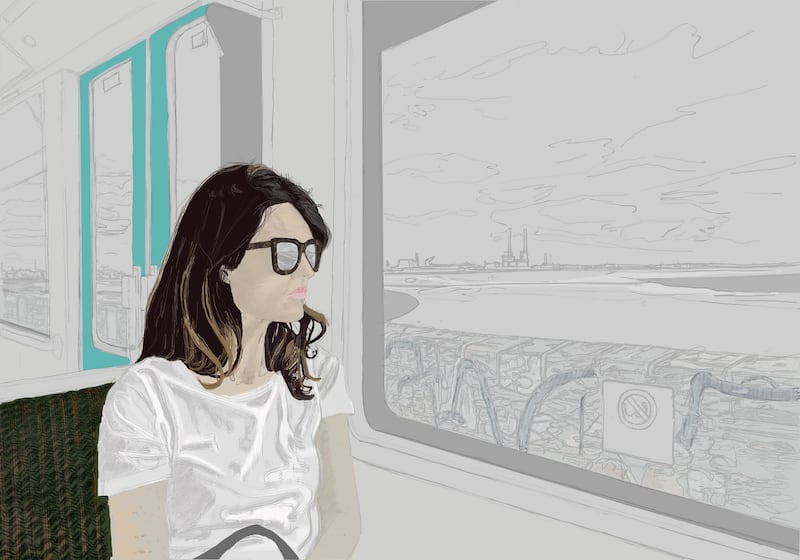In the summer of 1984 the train line between Bray and Howth was electrified and the Dart came gliding elegantly into the lives of delighted Dubliners.
Originally, the transport authorities considered hundreds of other names, including Bayline and Speedway, until focus groups baulked at anything with the words “line” or “speed”, because of the drug connotations. It was 1980s Dublin, after all.
In the end it was ingeniously named the Dart, which stands for Dublin Area Rapid Transit. Rapid both because it was rapid – Dublin slang for brilliant – and because it took only 16½ minutes to get from Dún Laoghaire, in south Co Dublin, into town.
We pressed our noses to the windows and saw our city in a way we'd never seen it before. We gazed down into people's back gardens and kitchens. We gasped as the sea came into view past the Merrion Gates
Before the arrival of the Dart our train system was a bit shoddy – or, as Frank McDonald put it in this newspaper at the time, "the worst service from the most obsolete rolling stock anywhere in the civilised world". The Dart changed the lives of Dubliners. It made the city better, cleaner, easier to navigate. It brought more people into the city centre and to scenic parts of Dublin – Dalkey, Sandycove, Howth, Malahide – they hadn't previously explored.
There was great excitement when the first Dart arrived at my home village of Sandymount. I was 13. In 1980s Dublin, in the middle of a prolonged recession, excitement was in short supply. I have a memory of balloons on the platform as we piled on to the brand new Dart train. We admired the sleek design, the push-button sliding doors, the plush green seats.
We went to Bray and back. We pressed our noses to the windows and saw our city in a way we’d never seen it before. We gazed down into people’s back gardens and kitchens. We gasped as the sea came into view past the Merrion Gates and on to Dún Laoghaire and beyond, as Dublin Bay and Dalkey Island and the poshest terrace of houses in the whole of Ireland revealed themselves like a painting.
I’ve loved the Dart ever since, and even after hundreds – thousands? – of journeys, whether in my school uniform, clutching my crumpled 10-journey ticket, or on seaside jaunts with my Leap card, it still gives me a thrill. I took the Dart from Connolly Station to Greystones and back the other day with my children. It was like going on holiday. “I love the Dart,” my daughter exclaimed when we got home. “I love the Dart, too,” I replied.

I’ve been thinking about the Dart because of Gary Coyle’s new exhibition, On Returning. The evocative drawings are all of the Dart. It’s the first time in his career that Coyle has worked in colour – he could hardly do Dart drawings without that iconic shade of green. Coyle, who has a collection of 3,000 Dart tickets, is clearly mad about the trains. Originally from Dún Laoghaire but now “in exile” on Dublin’s Northside, Coyle takes the Dart to swim daily at the Forty Foot.
In lockdown, when he couldn’t go anywhere, he immersed himself completely in these works of Dart. When I asked Coyle about the Dart’s appeal he said he enjoys the sense it gives him of being “between two places, emptying my mind”. He always brings a book on the Dart but never ends up reading it, because there is so much to look at both out of the window and in the train itself. His exhibition is extraordinarily beautiful and, for Dart lovers, moving.
I’ve also been thinking of the Dart because of the row over bicycle lanes in Dublin city. They started popping up all over the place during lockdown, and in the darkness of those days it felt as though something good and pure was happening, a contrast to all the misery. In those early weeks and months of the pandemic, when the streets of the capital were empty of cars, Dublin City Council workers were, to me anyway, like a gang of hardworking fairies sprinkling safer cycling infrastructure all over the city. As a nondriving cyclist, waking up to new cycle lanes in unexpected places was exciting, the way the Dart was exciting back in the day. They made our city better, cleaner, easier to navigate.
Much like the Dart gliding into recession-mauled 1980s Dublin, the cycle lanes and 'cycle buses' for children going to school were a good-news story at an awful time
Much like the Dart gliding into recession-mauled 1980s Dublin, the cycle lanes and “cycle buses” for children going to school were a good-news story at an awful time, because even small children know that ditching the car for cycling, even just one day a week, can make a serious impact on personal carbon emissions.
And yet even in the midst of a climate crisis, some people appear to be on a mission to dismantle the new cycling infrastructure in our city. Dublin City Council's plan to introduce a temporary two-lane cycleway along Sandymount Strand was challenged in the High Court by the Independent councillor Mannix Flynn and the Sandymount resident Peter Carvill for reasons they believe to be valid. They won their action. The city manager, Owen Keegan, said the decision will have "devastating consequences" for the development of the city's cycling infrastructure. A victorious Flynn predicted that a "vast number of cases" will be lodged in the courts before the end of this year in relation to cycling facilities installed during the pandemic.
Had the Sandymount cycleway been built, the plan was to link it to the two-way Coastal Mobility Route put in place by Dún Laoghaire-Rathdown County Council from Blackrock to Sandycove under Covid mobility measures last year. This would have led to an almost continuous protected cycleway running from Ringsend, in Dublin 4, all the way to Sandycove, about 12km away in south Co Dublin. Like we did when the Dart came, we'd have celebrated the arrival of a new piece of Dublin infrastructure. There would have been balloons.
The healthiest, most enjoyable and environmentally friendly way to get around our small capital city is by bike. Having been invested in and made safer during the pandemic, this benign mode of transport is, heartbreakingly, now under serious threat in Dublin.
“Since we started work in 1980 there has been tremendous goodwill towards the project, because people appreciate what we are doing,” said Dave Waters, the engineer in charge of the Dart back in 1984, referring to the support locals gave the project.
We should give thanks that the Dart wasn’t Mannixed back in the day. And offer appreciation, goodwill and support to Dublin City Council as it prepares to appeal this depressing High Court decision.
On Returning, Gary Coyle's exhibition, runs until Sunday, September 26th, 2021 at dlr Lexicon, in Dún Laoghaire, Co Dublin
roisin@irishtimes.com















